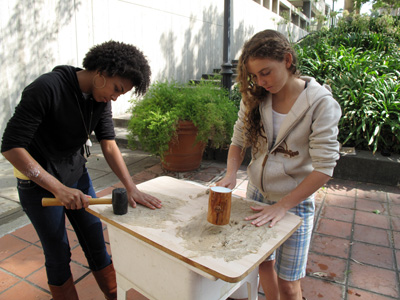 Scripps College students may mull over what to major in or which country to choose for a study abroad program, but one thing is certain: they enroll in a Core 3 as sophomores. This culmination of the Core Curriculum three-course sequence typically involves hands-on work, experiential learning, or community involvement. One course, for example, teaches a foreign language to elementary school students, while another creates educational websites as part of their study of cyberculture.
Scripps College students may mull over what to major in or which country to choose for a study abroad program, but one thing is certain: they enroll in a Core 3 as sophomores. This culmination of the Core Curriculum three-course sequence typically involves hands-on work, experiential learning, or community involvement. One course, for example, teaches a foreign language to elementary school students, while another creates educational websites as part of their study of cyberculture.
“From Materiality to Immateriality: The Coming of the Artist Book,” taught by Kitty Maryatt, Assistant Professor of Art and Director of the Scripps College Press, offers students opportunities not only to curate an exhibit of artist books in the Clark Humanities Museum but also to create their own handmade artist book.
“The goal of the course,” explains professor Maryatt, “is, by looking at thousands of years of book history, identify in contemporary artist books the innovative or representative. Students can select examples from our fabulous collection of milestones in the evolution of the artist book. This intellectual exploration is a prelude to making their own artist book.”
Ashley Africa ’13, an intended foreign languages major from Vancouver, British Columbia, was encouraged to take this Core 3 class by an older student. Ashley was excited to squeeze another art-related class into her schedule because she’d always had a creative bent.
“I had no real idea of what a book is,” Ashley admits. “It’s a bit conceptual and hard to grasp, but I like things that are hard to define. All of the Core Curriculum involves answering broad questions about sometimes intangible concepts without concrete definitions.”
But isn’t a book, well, a book?
“How do you record history?” counters professor Maryatt. “What do you record? Early records are of trade, of the ‘you gave me 3 sheep’ variety, not what we would consider ‘intellectual’ or ‘literature.’ Before paper, what did people write on? The answer? Everything. It’s an eye-opener for the students to study the history of the book.”
After research and student-led PowerPoint presentations on all aspects of the book — from language, to materials, to binding, to reproduction and printing, and images — students are introduced to the 10,000-12,000 volumes in the Rare Book Collection in Scripps’ Dennison Library, including hundreds of artist books.
“I guide them, help them navigate the collection,” says Judy Harvey Sahak ’64, Sally Preston Swan Librarian at Denison Library and Assistant Director of the Libraries of The Claremont Colleges. “We look in the Rare Book Collection for specific books illustrating a theme or area of study. The students seek artist books that illuminate examples of the book as an agent of social change or the book as conceptual space, for example.”
The exhibit, “Foundations: Groundwork for Contemporary Artist Books” ran from January 19 to March 12, 2010 and included both works from the Rare Book Collection and the students’ own artist books. The 35-page exhibition catalog contained the students’ research on the history of the book as well as detailed exhibition notes.
A weekend printmaking workshop, a day spent making paper, and a class session devoted to different binding techniques provides students with the basic tools and materials for their own artist books, which might not even be in codex (book) form but might be papyrus, scroll, or cuneiform.
For her final project, Julia Rigby ’12, an undecided major from Santa Ana, CA, chose a personal and familial memory. “I have always been interested in shadow books, which are composed of paper cutouts and are meant to be viewed with a flashlight in a dark room. Something about turning off the lights and flicking on a flashlight makes story-telling so much more mystical and special.”
Julia’s book, A Whistle in the Night, is a composition of various memories from family train trips across the country. “When you are on a train everything slides past the window pretty quickly, but certain images flash out at you and linger in your mind’s eye for a few moments longer — perhaps forever. These images — misty bayou waters, snow-capped mountains in the moonlight, withered prairie houses abandoned to the dry winds — were the images I wanted to record.”
“It was really fun to see what all the other students made,” says Ashley. “Everyone chose different forms. Arranging the exhibit was like a giant art project.”
Ashley’s artist book was an attempt to use art to represent her experience of music, Coldplay’s “Yellow,” specifically.
“I always have a song stuck in my head,” she explains, “and I always have images and motions in my head associated with that song. I took my own singular experience of the song and tried to put it into solid form. I made my own paper for the book and did everything by hand. Attempting to put into form what is in my head — that’s what the artist book is about.”
Scripps College Press
The Scripps College Press is pleased to invite you to the publication party for “ARCH,” the newest book from the Typography and the Book Arts class, with the assistance of Professor Kitty Maryatt. The event takes place Tuesday, May 4, 2010, from 4:30-5:30 p.m. at the Scripps College Press, Room 100, Lang Arts Building.

